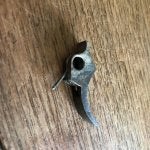Hello Everyone,
I've had my grandfather's Hopkins & Allen No. 722 take-down rolling block single-shot .22LR rifle for quite some time, and for years it was unshootable because it had a bullet stuck halfway down the barrel. This happened when my grandfather was a boy, and he said it was because he hadn't cleaned it frequently enough. It became his object lesson to me as a boy about why you should always clean your rifle after every use.
A few years ago I brought the barrel to a friend at work in my company's machine shop who is a shooter and antique gun enthusiast. He was able to gently coax the stuck bullet out of the barrel and return it to me cleared.
There was some pitting in the area where the bullet had been lodged, but overall the barrel was in good enough condition to shoot. I cleaned it up and put it back together for a trial.
It worked great with one exception. The trigger seemed like the return spring was weak and put very little forward pressure on the trigger. Upon disassembly, I found the problem to be a cracked trigger return spring.
![]()
![]()
The spring has an unusual shape, but is nonetheless pretty simple. I was hoping someone here might know where I could find a replacement, or where I might have one made. Or, if someone can tell me about the correct type of spring wire to use, perhaps I can simply make a replacement myself.
I've had my grandfather's Hopkins & Allen No. 722 take-down rolling block single-shot .22LR rifle for quite some time, and for years it was unshootable because it had a bullet stuck halfway down the barrel. This happened when my grandfather was a boy, and he said it was because he hadn't cleaned it frequently enough. It became his object lesson to me as a boy about why you should always clean your rifle after every use.
A few years ago I brought the barrel to a friend at work in my company's machine shop who is a shooter and antique gun enthusiast. He was able to gently coax the stuck bullet out of the barrel and return it to me cleared.
There was some pitting in the area where the bullet had been lodged, but overall the barrel was in good enough condition to shoot. I cleaned it up and put it back together for a trial.
It worked great with one exception. The trigger seemed like the return spring was weak and put very little forward pressure on the trigger. Upon disassembly, I found the problem to be a cracked trigger return spring.


The spring has an unusual shape, but is nonetheless pretty simple. I was hoping someone here might know where I could find a replacement, or where I might have one made. Or, if someone can tell me about the correct type of spring wire to use, perhaps I can simply make a replacement myself.












